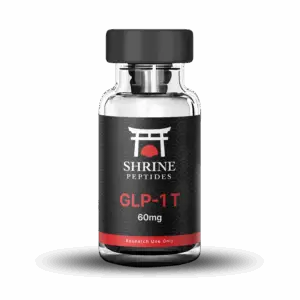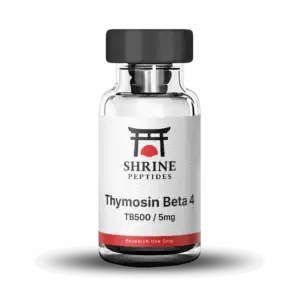BPC-157 (5mg)
$58.00
BPC-157 5mg – Body Protection Compound pentadecapeptide for gastric tissue research and cellular repair studies | Research Use Only – Not for Human Consumption
BPC-157 Peptide Research Compound
Research Use Only – Not for Human or Animal Consumption
BPC-157, designated as Body Protection Compound-157, is a synthetically derived pentadecapeptide consisting of 15 amino acid residues.1 This research compound is recognized as a partial sequence of the endogenous body protection compound discovered in gastric juice. BPC-157 has been extensively investigated in laboratory settings for its potential cytoprotective properties and tissue regeneration characteristics. Preliminary research has indicated that this peptide may modulate various physiological pathways involved in cellular repair mechanisms, angiogenesis, and inflammatory response modulation.2
Mechanism of Action Overview
Laboratory investigations have suggested that BPC-157 may interact with multiple signaling pathways involved in tissue protection and regeneration. Research data indicates this peptide may influence growth factor expression, including vascular endothelial growth factor (VEGF), which plays a crucial role in angiogenesis and vascular repair processes.3 Additionally, BPC-157 has been observed to potentially modulate nitric oxide (NO) pathways, which are fundamental to vascular function and tissue healing mechanisms.
Studies have indicated that BPC-157 may promote the stabilization of cellular structures and enhance the migration of cells involved in tissue repair, including fibroblasts and endothelial cells.4 The peptide has been hypothesized to accelerate healing processes through multiple mechanisms, including potential enhancement of collagen formation, modulation of inflammatory mediators, and promotion of blood vessel formation in damaged tissues. Research suggests that BPC-157 may also interact with the FAK-paxillin pathway, which is involved in cell adhesion and migration processes critical for tissue repair.5
BPC-157 Chemical Structure
Sequence: Gly-Glu-Pro-Pro-Pro-Gly-Lys-Pro-Ala-Asp-Asp-Ala-Gly-Leu-Val
Molecular formula: C₆₂H₉₈N₁₆O₂₂
Molecular weight: 1419.53 g/mol
Form: Lyophilized powder
Purity: >99% (HPLC verified)
Research and Preclinical Studies
Tissue Repair Investigations
Extensive preclinical research has been conducted to evaluate the potential effects of BPC-157 on various tissue types. In controlled laboratory settings utilizing murine models, researchers have investigated the peptide’s influence on tendon healing, ligament repair, and muscle tissue regeneration.6 Data from these studies have suggested that BPC-157 administration may correlate with accelerated healing timelines and improved tissue quality markers in experimental injury models. Specifically, research has indicated potential enhancement of tendon-to-bone healing, increased cellular proliferation at injury sites, and modulation of extracellular matrix composition during tissue repair processes.
Gastrointestinal Research
Given its origin as a gastric peptide, significant research has focused on BPC-157’s potential effects on gastrointestinal tissues. Laboratory investigations have examined the peptide’s influence on gastric ulcer healing, intestinal anastomosis integrity, and inflammatory bowel conditions in animal models.7 Research data has suggested that BPC-157 may promote mucosal healing through multiple mechanisms, including potential modulation of growth factor expression, enhancement of epithelial cell migration, and regulation of inflammatory mediator production. Studies have also explored the peptide’s potential effects on gut-brain axis signaling and gastrointestinal motility regulation.
Vascular and Angiogenic Research
Research teams have investigated BPC-157’s potential influence on vascular function and new blood vessel formation. Laboratory studies have suggested that the peptide may promote angiogenesis through VEGF-dependent and potentially VEGF-independent pathways.8 In experimental models of vascular injury, BPC-157 administration has been associated with enhanced endothelial cell proliferation, improved vascular stability, and increased blood flow to ischemic tissues. These findings have contributed to ongoing research into the peptide’s potential applications in vascular research and ischemia-reperfusion injury models.
Product Specifications
- Size: 5mg per vial
- Contents: BPC-157 (5mg)
- Form: Lyophilized powder
- Purity: >99% (verified by HPLC and Mass Spectrometry)
- Storage: Store at -20°C in a dry environment
- Reconstitution: Use bacteriostatic water for laboratory applications
- Stability: Stable when stored properly; reconstituted solutions should be used promptly
Quality Assurance and Documentation
- Third-party laboratory tested for purity and identity verification
- Certificate of Analysis (COA) available upon request for each batch
- HPLC chromatography results provided
- Mass spectrometry data available
- Manufactured under strict quality control protocols
- Batch-specific documentation and traceability
- Compliance with research-grade standards
Research Applications
- Tissue repair and regeneration mechanism studies
- Gastrointestinal healing pathway research
- Angiogenesis and vascular function investigations
- Inflammatory response modulation studies
- Growth factor signaling pathway research
- Cellular migration and adhesion studies
- Extracellular matrix remodeling research
- Wound healing mechanism investigations
- Ischemia-reperfusion injury models
- Cytoprotection mechanism studies
Important Research Notice
FOR LABORATORY AND RESEARCH USE ONLY. This product is intended exclusively for scientific research, in vitro studies, and laboratory investigations. This compound is not intended for human or animal consumption, clinical applications, or any diagnostic or therapeutic uses.
Researchers should consult relevant scientific literature and follow appropriate safety protocols when handling this research compound. Proper laboratory equipment, personal protective equipment, and training are required for working with this material.
Regulatory Compliance Statement
This product is sold as a research chemical for laboratory use only. Shrine Peptides operates as a chemical supplier. Shrine Peptides is not a compounding pharmacy or chemical compounding facility as defined under 503A of the Federal Food, Drug, and Cosmetic Act. Shrine Peptides is not an outsourcing facility as defined under 503B of the Federal Food, Drug, and Cosmetic Act.
The statements made within this product description have not been evaluated by the US Food and Drug Administration. The products we offer are not intended to diagnose, treat, cure or prevent any disease. Human/Animal Consumption Prohibited. Laboratory/In-Vitro Experimental Use Only.
Please review and adhere to our Terms and Conditions before ordering.
References:
- Chang, Chung-Hsun et al. “The promoting effect of pentadecapeptide BPC 157 on tendon healing involves tendon outgrowth, cell survival, and cell migration.” Journal of applied physiology (Bethesda, Md. : 1985) vol. 110,3 (2011): 774-80. doi:10.1152/japplphysiol.00945.2010. https://pubmed.ncbi.nlm.nih.gov/21030672/
- Ormsbee, H S 3rd, and J D Fondacaro. “Action of serotonin on the gastrointestinal tract.” Proceedings of the Society for Experimental Biology and Medicine. Society for Experimental Biology and Medicine (New York, N.Y.) vol. 178,3 (1985): 333-8. doi:10.3181/00379727-178-42016. https://pubmed.ncbi.nlm.nih.gov/3919396/
- Sikiric, Predrag et al. “Brain-gut Axis and Pentadecapeptide BPC 157: Theoretical and Practical Implications.” Current neuropharmacology vol. 14,8 (2016): 857-865. doi:10.2174/1570159×13666160502153022. https://www.ncbi.nlm.nih.gov/pmc/articles/PMC5333585/#r1
- Krivic, A., Majerovic, M., Jelic, I. et al. Modulation of early functional recovery of Achilles tendon to bone unit after transection by BPC 157 and methylprednisolone. Inflamm. res. 57, 205–210 (2008). https://doi.org/10.1007/s00011-007-7056-8
- S Seiwerth, et al. “BPC 157’s effect on healing.” Journal of physiology, Paris vol. 91,3-5 (1997): 173-8. doi:10.1016/s0928-4257(97)89480-6. https://pubmed.ncbi.nlm.nih.gov/9403790/
- Huang, T., Zhang, K., Sun, L., Xue, X., Zhang, C., Shu, Z., Mu, N., Gu, J., Zhang, W., Wang, Y., Zhang, Y., & Zhang, W. (2015). Body protective compound-157 enhances alkali-burn wound healing in vivo and promotes proliferation, migration, and angiogenesis in vitro. Drug design, development and therapy, 9, 2485–2499. https://doi.org/10.2147/DDDT.S82030
- Seiwerth, Sven et al. “BPC 157 and Standard Angiogenic Growth Factors. Gastrointestinal Tract Healing, Lessons from Tendon, Ligament, Muscle and Bone Healing.” Current pharmaceutical design vol. 24,18 (2018): 1972-1989. doi:10.2174/1381612824666180712110447. https://pubmed.ncbi.nlm.nih.gov/29998800/
- Sikiric P. (1999). The pharmacological properties of the novel peptide BPC 157 (PL-10). Inflammopharmacology, 7(1), 1–14. https://doi.org/10.1007/s10787-999-0022-z https://pubmed.ncbi.nlm.nih.gov/17657443/
- Pevec D, Novinscak T, Brcic L, Sipos K, Jukic I, Staresinic M, Mise S, Brcic I, Kolenc D, Klicek R, Banic T, Sever M, Kocijan A, Berkopic L, Radic B, Buljat G, Anic T, Zoricic I, Bojanic I, Seiwerth S, Sikiric P. Impact of pentadecapeptide BPC 157 on muscle healing impaired by systemic corticosteroid application. Med Sci Monit. 2010 Mar;16(3):BR81-88. PMID: 20190676. https://pubmed.ncbi.nlm.nih.gov/20190676/
- Jelovac, N et al. “A novel pentadecapeptide, BPC 157, blocks the stereotypy produced acutely by amphetamine and the development of haloperidol-induced supersensitivity to amphetamine.” Biological psychiatry vol. 43,7 (1998): 511-9. doi:10.1016/s0006-3223(97)00277-1. https://pubmed.ncbi.nlm.nih.gov/9547930/
- Tudor, M., Jandric, I., Marovic, A., Gjurasin, M., Perovic, D., Radic, B., Blagaic, A. B., Kolenc, D., Brcic, L., Zarkovic, K., Seiwerth, S., & Sikiric, P. (2010). Traumatic brain injury in mice and pentadecapeptide BPC 157 effect. Regulatory peptides, 160(1-3), 26–32. https://doi.org/10.1016/j.regpep.2009.11.012
- Gwyer, D., Wragg, N.M. & Wilson, S.L. Gastric pentadecapeptide body protection compound BPC 157 and its role in accelerating musculoskeletal soft tissue healing. Cell Tissue Res 377, 153–159 (2019). https://doi.org/10.1007/s00441-019-03016-8
- Veljaca, Marija et al, The development of PL 14736 for treatment of inflammatory bowel disease, Advanced in GI pharmacology, 2002 O-32. https://www.bib.irb.hr/192824
- Phase I clinical trial in healthy volunteers to study safety and pharmacokinetics of BPC-157, a pentadecapeptide from gastric source. https://clinicaltrials.gov/ct2/show/NCT02637284?








Reviews
There are no reviews yet.